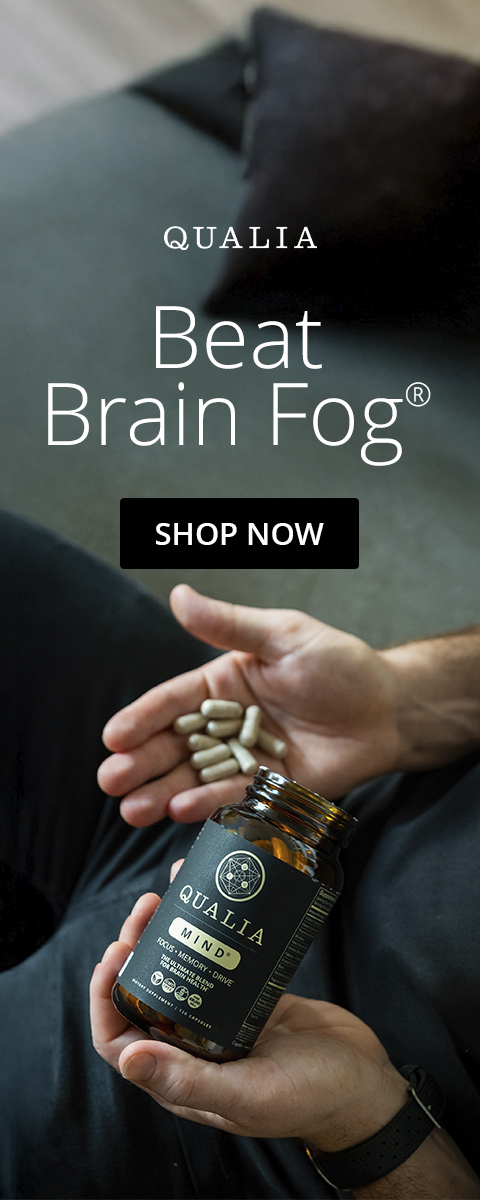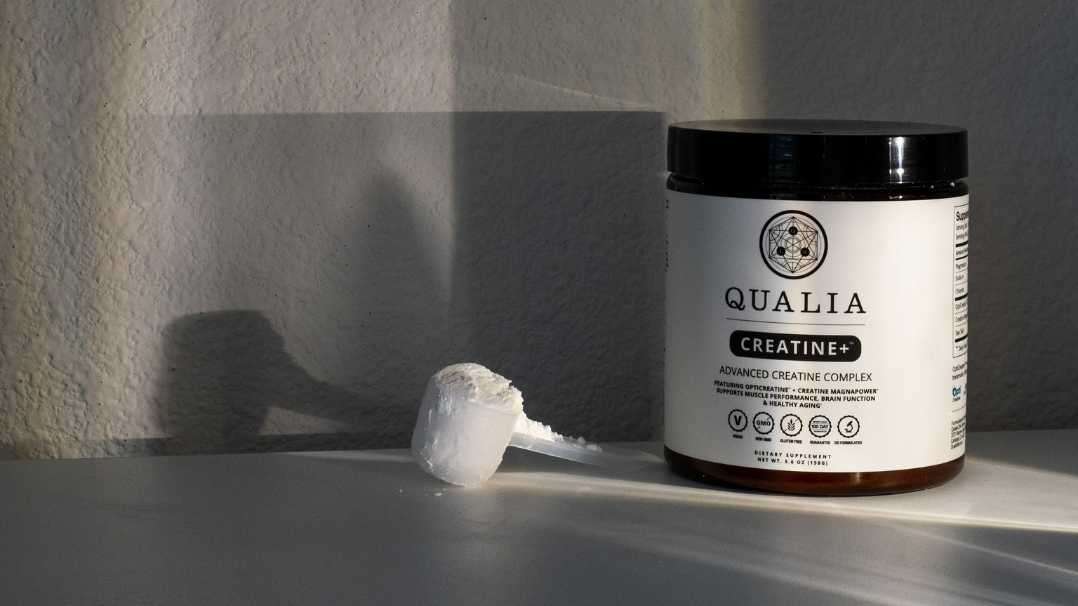Have you ever struggled to concentrate, felt forgetful, or experienced mental sluggishness despite getting a full night’s sleep? If so, you’re not alone. These symptoms, often described as brain fog, are incredibly common. They can result from stress, poor sleep, or poor diet, for example, and can affect anyone.
Brain fog can be frustrating, impacting productivity, decision-making, and overall well-being. But you don’t have to accept brain fog as a permanent state. This article explores natural strategies to support mental clarity, sharpen focus, and regain cognitive energy. *
Understanding Brain Fog
What Is Brain Fog?
Brain fog refers to a state of low mental energy that makes it difficult to do mental work. Brain fog can manifest in many ways, including mental fatigue, lack of mental clarity, sluggish thinking, clouded judgment, difficulty focusing, difficulty concentrating, difficulty blocking out distractions, delayed word recall, scattered short-term memory, difficulty keeping a train of thought, and lack of motivation.
Brain fog is not a condition per se but rather a symptom of something else, such as being overworked, stressed, or sleep-deprived. In these circumstances, a person’s cognitive demands typically exceed their available cognitive and physiological resources. A feeling of brain fog is a consequence of this mismatch. Brain fog can hinder your ability to perform tasks that require mental effort, such as sustaining attention, planning, making decisions, and multitasking. Additionally, the fatigue associated with brain fog can also impact your physical energy levels, making both work and daily routines more challenging.
Common Causes of Brain Fog
Diet
The brain depends on nutrients obtained from food to produce energy, build essential molecules, and synthesize neurotransmitters. Vitamins, minerals, amino acids, and other dietary compounds from our diet are crucial for enzyme function and serve as precursors for neurotransmitter synthesis. Some foods also contain bioactive compounds that support these processes or affect brain signaling pathways. When the brain doesn’t receive enough nutrients, its function can be compromised. Moreover, poor dietary choices can interfere with nutrient absorption, distribution, and metabolism. Unhealthy foods can also impair the brain’s ability to detoxify, leading to oxidative stress and the buildup of harmful metabolic byproducts—factors that may contribute to brain fog.
Physical Inactivity
Sedentary behavior and lack of physical activity are linked to poorer overall health, especially metabolic and cardiovascular function [17,18]. This has significant implications for the brain, which relies on a steady and efficient supply of oxygen and nutrients to meet its high energy demands. As a result, the brain is particularly vulnerable to the effects of poor vascular and metabolic health. When it doesn't receive the fuel and oxygen it needs, its performance declines—often experienced as brain fog. Extended periods of inactivity, such as sitting for long stretches, have been associated with reduced cognitive performance, increased physical and mental fatigue, and decreased motivation [1–4], all of which contribute to the experience of brain fog.
Stress
Stress triggers the release of cortisol and other stress hormones, which can disrupt sleep and affect cognition and mental health [5–7]. The body interprets stress as a physiological threat, so it places the body and mind in a state of high alertness that is demanding for our mental energy and cognitive resources [8–10]. This may affect cognitive performance and result in feelings of fatigue, burnout, and brain fog [11–13].
Poor Sleep
Sleep is vital for maintaining a healthy mind. It plays several crucial roles, including regenerating the body, clearing out daily metabolic waste from the brain, regulating metabolism and energy levels, and supporting memory and learning; it is also essential for cognitive performance and mood during the day [14,15]. When sleep is consistently poor, the brain struggles to perform at its best. Common consequences of inadequate sleep include decreased alertness, slower processing speed, and impaired attention and vigilance—all of which hinder mental performance. In addition, poor sleep disrupts emotional regulation and makes it harder to cope with stress, further impairing cognitive abilities [16]. These effects often present as brain fog.
Lifestyle Strategies to Overcome Brain Fog
Healthy Diet
A diverse and well-balanced diet can provide all the essential nutrients your brain needs. To help reduce brain fog, focus on eating a variety of healthy foods, especially fruits, vegetables, whole grains, healthy fats, and unprocessed sources of protein, while limiting alcohol and heavily processed, salty, fatty, or sugary items. It's also important to avoid foods you may be allergic or sensitive to, as they can impact your metabolism and brain function. For instance, some individuals with gluten sensitivity experience brain fog [17]. Water is also vital for a healthy brain, so remember to stay well-hydrated to keep your brain running optimally [18].
Regular Physical Activity
Regular physical activity and exercise play a key role in maintaining healthy brain function by promoting cerebral blood flow and supporting metabolism, which can help protect against brain fog. Research has shown that interrupting long periods of sitting with short bouts of movement—such as standing, light walking, climbing stairs, or doing simple calisthenics—can prevent reductions in cerebral blood flow, promote cardiovascular health, enhance metabolic markers, delay the onset of fatigue, promote healthy stress responses, and boost mental performance, particularly attention and executive function [3,19–23].
Stress Management Techniques
Completely removing stress from our lives isn’t always realistic, but finding strategies that help manage stress effectively and minimize its impact can play a significant role in reducing or preventing brain fog. Practices that promote stress resilience, such as yoga, breathwork, meditation, and physical activity, can help you stay calm and promote mental clarity and cognitive performance [24–26]. Over time, these practices can enhance emotional resilience and reduce the mental fatigue that often contributes to brain fog.
Adequate Sleep
Quality sleep is essential for feeling energized, motivated, and mentally sharp [27,28]. For the brain to fully recharge, it needs to cycle through all the stages of sleep. Practicing good sleep hygiene can help you get more restful, restorative sleep. This includes sticking to a consistent sleep schedule, keeping your bedroom dark, quiet, cool, and calming, avoiding screens for 30 to 60 minutes before bed, and steering clear of heavy meals, caffeine, and alcohol late in the evening [29,30]. For many people, cutting off caffeine after noon can also lead to better sleep.
Mental Exercises
Cognitive training can be an effective way to combat brain fog by supporting neuroplasticity and strengthening mental functions such as memory [31,32]. Mental exercises may stimulate the brain and help to keep it active and adaptable, which may help reduce the sluggishness and confusion often associated with brain fog. Incorporating a variety of mentally stimulating tasks into your daily routine not only helps sharpen focus but also supports long-term cognitive health, making it easier to stay clear-headed and alert.
Digital Detox
Prolonged exposure to screens can overload the brain with constant stimulation, disrupt sleep patterns, and reduce time spent on restorative activities like physical movement and face-to-face social interaction. This can contribute to brain fog and poorer cognitive performance, leaving you feeling mentally sluggish, unfocused, and drained [33–36]. To combat this, it’s important to take regular breaks from screens to refresh your mind, reduce cognitive strain, and help maintain better overall mental clarity throughout the day.
The Role of Nootropic Supplements
What Are Nootropics?
In addition to a healthy diet, certain supplements can support brain performance and help reduce or avert brain fog. Nootropics are substances that promote cognitive performance in healthy individuals by supporting and protecting, either directly or indirectly, brain structure and function. There are many ingredients with nootropic activity, including natural compounds such as vitamins, minerals, amino acids, herbs or other botanical extracts, mushrooms, or other dietary substances; they can be synthetic compounds [37]. *
Many of these compounds are simply nutrients naturally found in the brain (e.g., choline, B vitamins, magnesium) and that play important roles in cognitive function, brain energy production, and nervous system health. Others support brain health and function by promoting healthy physiological responses in the brain. *
Overall, nootropics may support such functions as:
Neurotransmitter synthesis and recycling;*
Neuronal communication and synaptic transmission;*
Cerebral blood flow;*
Cerebral metabolism and energy production;*
Neuronal and brain structure; *
Neuroprotective and detox functions.*
The benefits of nootropics for cognitive performance are a consequence, either direct or indirect, of benefiting these physiological processes that underlie all types of cognitive functions—from memory and learning, to executive functions, reasoning, attention, focus, creativity, motivation, and mood. *
Qualia Mind: A Comprehensive Nootropic
QUALIA MIND® is a nootropic supplement that combines 32 ingredients that have been carefully selected to support alertness, energy, focus, memory, mood, and motivation.*
Mental activity, like physical work, requires energy and uses resources. And, the more demanding, effortful, or sustained the thinking, the more energy that’s required. When the brain can’t meet its energy demands, brain fog can set in.
QUALIA MIND was created to support the brain in making and investing energy more efficiently so that you can feel motivated and focused. *
Key Ingredients and Their Science-Backed Benefits
Caffeine
Caffeine is one of the most used and studied nootropic compounds. Caffeine is a central nervous system stimulant that promotes wakefulness and supports resistance to mental fatigue. Research has shown that caffeine promotes alertness, attention, reaction time, information processing, executive function, reasoning, and even creative thinking, all of which contribute to our capacity for mental work [38–45].*
L-Theanine
L-theanine is an amino acid found in tea. L-theanine has calming effects by promoting alpha brain waves, which are a marker of relaxation [46,47]. It is used as a nootropic because it supports reaction time, focused attention, mental alertness, and a calm, relaxed sense of mental energy [48–53]. L-theanine is often combined with caffeine because it helps to balance its stimulating effects. Together, they support alertness, attention, mood, and cognition [54–58].*
CDP-choline
CDP-choline, or citicoline, is a choline-containing compound that can be used to support brain choline levels. Choline is a precursor for the neurotransmitter acetylcholine, which plays an important part in promoting attention, concentration, mental focus, and memory [59,60]. CDP-choline is also a precursor for the phospholipid phosphatidylcholine, a component of cell membranes needed for healthy cell function [61,62].*
B Vitamins
B-complex vitamins are a group of vitamins often given together because of the interrelated nature of some of their functions. Individually and collectively, B vitamins are important for upholding brain function. All of the B vitamins are involved in some way in supporting cellular metabolism and energy production, which is essential for healthy cognitive performance. Vitamins B1, B6, and B12 also support optimal nerve health and function [63]. Vitamin B6, B12, and folic acid collectively support the methylation cycle, which is needed to produce neurotransmitters like dopamine and serotonin [64]. B vitamins, particularly B1 and B5, play important functional roles in supporting a healthy response to stress.*
Magnesium
Magnesium is an essential mineral with crucial functions in the brain. Magnesium is involved in all biochemical and metabolic pathways of cellular energy metabolism and is necessary for neurotransmitter synthesis, synaptic transmission, neuroplasticity, and neuroprotection, all of which are essential for brain health and cognitive function [65]. Maintaining healthy brain levels of magnesium is crucial for maintaining healthy cognitive performance, particularly as we age [66,67]. Clinical studies have indicated that people who consume diets rich in magnesium may have healthier brain function during aging [68,69].*
Lion's Mane Mushroom
Lion’s Mane (Hericium erinaceus) is a mushroom that may promote brain health by supporting neuroprotective functions and healthy brain structure [70]. In preclinical studies, Lion’s Mane supported dendrite growth and myelination, both of which contribute to the efficiency of neuronal communication [71–73]. In a clinical study, Lion’s Mane helped to maintain healthy brain structure and neural organization in older individuals [74].*
SmartSeed™ Celastrus paniculatus
Celastrus paniculatus is a herb with a long history of use as a brain tonic to alleviate mental fatigue and support mental acuity, memory and intellect [75]. Because of these traditional uses, Celastrus is also known as “the intellect tree.” Celastrus promotes antioxidant defenses and neuroprotective functions in the brain and supports neurotransmitter systems [76–86]. These effects may underlie the support of cognitive function observed in preclinical research [76,81,85–87].* Qualia Life values Celastrus paniculatus so much that we’ve had an extract made specially for us. SmartSeed™ is the trademarked name we’ve given our Celastrus paniculatus extract.*
Ginkgo biloba
Ginkgo biloba is a popular herbal extract used for healthy brain performance. Research suggests that Ginkgo extracts may support healthy neurotransmitter systems (e.g., acetylcholine, dopamine), neuroplasticity, neuroprotection, and blood flow to the brain [88–90]. As a nootropic, Ginkgo is best known for supporting cognitive skills related to concentration, attention, memory, and mood. Ginkgo may also support hearing [91,92] and metabolic health [93].*
Learn more about Qualia Mind and its ingredients here: Qualia Mind Ingredients.
*These statements have not been evaluated by the Food and Drug Administration. This product is not intended to diagnose, treat, cure, or prevent any disease.
References:
[1]R.S. Falck, J.C. Davis, T. Liu-Ambrose, Br. J. Sports Med. 51 (2017) 800–811.
[2]M.J. Koohsari, T. Nakaya, G.R. McCormack, A. Shibata, K. Ishii, K. Oka, JMIR Public Health Surveill 7 (2021) e26293.
[3]P. Wennberg, C.-J. Boraxbekk, M. Wheeler, B. Howard, P.C. Dempsey, G. Lambert, N. Eikelis, R. Larsen, P. Sethi, J. Occleston, J. Hernestål-Boman, K.A. Ellis, N. Owen, D.W. Dunstan, BMJ Open 6 (2016) e009630.
[4]I. Engberg, J. Segerstedt, G. Waller, P. Wennberg, M. Eliasson, BMC Public Health 17 (2017) 654.
[5]S.J. Lupien, B.S. McEwen, M.R. Gunnar, C. Heim, Nat. Rev. Neurosci. 10 (2009) 434–445.
[6]K.A. James, J.I. Stromin, N. Steenkamp, M.I. Combrinck, Front. Endocrinol. (Lausanne) 14 (2023) 1085950.
[7]V. Lo Martire, D. Caruso, L. Palagini, G. Zoccoli, S. Bastianini, Neurosci. Biobehav. Rev. 117 (2020) 65–77.
[8]I.M. Sokolova, Integr. Comp. Biol. 53 (2013) 597–608.
[9]G. Russell, S. Lightman, Nat. Rev. Endocrinol. 15 (2019) 525–534.
[10]N. Tsai, J.S. Eccles, S.M. Jaeggi, Brain Cogn. 133 (2019) 54–59.
[11]F.S. Dhabhar, Front. Neuroendocrinol. 49 (2018) 175–192.
[12]M.F. Dallman, S. Bhatnagar, Comprehensive Physiology (2011).
[13]K. Glise, G. Ahlborg Jr, I.H. Jonsdottir, BMC Psychiatry 14 (2014) 118.
[14]K.C. Simon, L. Nadel, J.D. Payne, Proc. Natl. Acad. Sci. U. S. A. 119 (2022) e2201795119.
[15]M.R. Zielinski, J.T. McKenna, R.W. McCarley, AIMS Neurosci 3 (2016) 67–104.
[16]W.D.S. Killgore, Prog. Brain Res. 185 (2010) 105–129.
[17]I.D. Croall, N. Hoggard, I. Aziz, M. Hadjivassiliou, D.S. Sanders, PLoS One 15 (2020) e0238283.
[18]J. Zhang, G. Ma, S. Du, S. Liu, N. Zhang, Nutrients 13 (2021).
[19]S.E. Carter, R. Draijer, S.M. Holder, L. Brown, D.H.J. Thijssen, N.D. Hopkins, J. Appl. Physiol. 125 (2018) 790–798.
[20]G.O. da Silva, L.B. Santini, B.Q. Farah, A.H. Germano-Soares, M.A. Correia, R.M. Ritti-Dias, Int. J. Sports Med. 43 (2022) 97–106.
[21]R. Loh, E. Stamatakis, D. Folkerts, J.E. Allgrove, H.J. Moir, Sports Med. 50 (2020) 295–330.
[22]A.J. Chauntry, N.C. Bishop, M. Hamer, N.J. Paine, Ann. Behav. Med. (2022).
[23]B.C.R. Chrismas, L. Taylor, A. Cherif, S. Sayegh, D.P. Bailey, PLoS One 14 (2019) e0219565.
[24]A.L. Francis, R.C. Beemer, Complement. Ther. Med. 43 (2019) 170–175.
[25]Y.-Y. Tang, B.K. Hölzel, M.I. Posner, Nat. Rev. Neurosci. 16 (2015) 213–225.
[26]B. Stubbs, D. Vancampfort, S. Rosenbaum, J. Firth, T. Cosco, N. Veronese, G.A. Salum, F.B. Schuch, Psychiatry Res. 249 (2017) 102–108.
[27]S.J. McCarter, P.T. Hagen, E.K. St Louis, T.M. Rieck, C.R. Haider, D.R. Holmes, T.I. Morgenthaler, Sleep Med. Rev. 64 (2022) 101657.
[28]A.J. Scott, T.L. Webb, M. Martyn-St James, G. Rowse, S. Weich, Sleep Med. Rev. 60 (2021) 101556.
[29]M. Sejbuk, I. Mirończuk-Chodakowska, A.M. Witkowska, Nutrients 14 (2022).
[30]O. Troynikov, C.G. Watson, N. Nawaz, J. Therm. Biol. 78 (2018) 192–203.
[31]A. Engvig, A.M. Fjell, L.T. Westlye, T. Moberget, Ø. Sundseth, V.A. Larsen, K.B. Walhovd, Neuroimage 52 (2010) 1667–1676.
[32]M. Lövdén, N.C. Bodammer, S. Kühn, J. Kaufmann, H. Schütze, C. Tempelmann, H.-J. Heinze, E. Düzel, F. Schmiedek, U. Lindenberger, Neuropsychologia 48 (2010) 3878–3883.
[33]M.I. Silvani, R. Werder, C. Perret, Front. Physiol. 13 (2022) 943108.
[34]G.W. Small, J. Lee, A. Kaufman, J. Jalil, P. Siddarth, H. Gaddipati, T.D. Moody, S.Y. Bookheimer, Dialogues Clin. Neurosci. 22 (2020) 179–187.
[35]N. Stiglic, R.M. Viner, BMJ Open 9 (2019) e023191.
[36]J. Owolabi, O.S. Ilesanmi, A. Luximon-Ramma, Cureus 13 (2021) e18211.
[37]M. Malík, P. Tlustoš, Nutrients 14 (2022) 3367.
[38]T.M. McLellan, J.A. Caldwell, H.R. Lieberman, Neurosci. Biobehav. Rev. 71 (2016) 294–312.
[39]A. Smith, Food Chem. Toxicol. 40 (2002) 1243–1255.
[40]S.J.L. Einöther, T. Giesbrecht, Psychopharmacology 225 (2013) 251–274.
[41]J. Lanini, J.C.F. Galduróz, S. Pompéia, Hum. Psychopharmacol. 31 (2016) 29–43.
[42]A. Nehlig, J. Alzheimers. Dis. 20 Suppl 1 (2010) S85–94.
[43]C.H.S. Ruxton, Nutr. Bull. 33 (2008) 15–25.
[44]K. Soar, E. Chapman, N. Lavan, A.S. Jansari, J.J.D. Turner, Appetite 105 (2016) 156–163.
[45]M.J. Jarvis, Psychopharmacology 110 (1993) 45–52.
[46]L.R. Juneja, D.-C. Chu, T. Okubo, Y. Nagato, H. Yokogoshi, Trends Food Sci. Technol. 10 (1999) 199–204.
[47]C.H. Song, J.H. Jung, J.S. Oh, K.S. Kim, Korean Journal of Nutrition 36 (2003) 918–923.
[48]A. Higashiyama, H.H. Htay, M. Ozeki, L.R. Juneja, M.P. Kapoor, J. Funct. Foods 3 (2011) 171–178.
[49]S.-K. Park, I.-C. Jung, W.K. Lee, Y.S. Lee, H.K. Park, H.J. Go, K. Kim, N.K. Lim, J.T. Hong, S.Y. Ly, S.S. Rho, J. Med. Food 14 (2011) 334–343.
[50]S. Hidese, S. Ogawa, M. Ota, I. Ishida, Z. Yasukawa, M. Ozeki, H. Kunugi, Nutrients 11 (2019).
[51]M. Gomez-Ramirez, B.A. Higgins, J.A. Rycroft, G.N. Owen, J. Mahoney, M. Shpaner, J.J. Foxe, Clin. Neuropharmacol. 30 (2007) 25–38.
[52]A.C. Nobre, A. Rao, G.N. Owen, Asia Pac. J. Clin. Nutr. 17 Suppl 1 (2008) 167–168.
[53]D.J. White, S. de Klerk, W. Woods, S. Gondalia, C. Noonan, A.B. Scholey, Nutrients 8 (2016).
[54]C.F. Haskell, D.O. Kennedy, A.L. Milne, K.A. Wesnes, A.B. Scholey, Biol. Psychol. 77 (2008) 113–122.
[55]S.J.L. Einöther, V.E.G. Martens, J.A. Rycroft, E.A. De Bruin, Appetite 54 (2010) 406–409.
[56]T. Giesbrecht, J.A. Rycroft, M.J. Rowson, E.A. De Bruin, Nutr. Neurosci. 13 (2010) 283–290.
[57]G.N. Owen, H. Parnell, E.A. De Bruin, J.A. Rycroft, Nutr. Neurosci. 11 (2008) 193–198.
[58]C.N. Kahathuduwa, T.L. Dassanayake, A.M.T. Amarakoon, V.S. Weerasinghe, Nutr. Neurosci. 20 (2017) 369–377.
[59]G.B. Weiss, Life Sci. 56 (1995) 637–660.
[60]S.K. Fisher, S. Wonnacott, in: S.T. Brady, G.J. Siegel, R.W. Albers, D.L. Price (Eds.), Basic Neurochemistry (Eighth Edition), Academic Press, New York, 2012, pp. 258–282.
[61]J. Agut, E. Font, A. Sacristán, J.A. Ortiz, Arzneimittelforschung 33 (1983) 1048–1050.
[62]P. Galletti, M. De Rosa, M.G. Cotticelli, A. Morana, R. Vaccaro, V. Zappia, J. Neurol. Sci. 103 Suppl (1991) S19–25.
[63]S. Baltrusch, Biomed Res. Int. 2021 (2021) 9968228.
[64]D. Kennedy, Nutrients 8 (2016) 68.
[65]J.A.M. Maier, L. Locatelli, G. Fedele, A. Cazzaniga, A. Mazur, Int. J. Mol. Sci. 24 (2022).
[66]M. Barbagallo, L.J. Dominguez, Curr. Pharm. Des. 16 (2010) 832–839.
[67]M. Barbagallo, N. Veronese, L.J. Dominguez, Nutrients 13 (2021).
[68]N. Cherbuin, R. Kumar, P.S. Sachdev, K.J. Anstey, Front. Aging Neurosci. 6 (2014) 4.
[69]M. Ozawa, T. Ninomiya, T. Ohara, Y. Hirakawa, Y. Doi, J. Hata, K. Uchida, T. Shirota, T. Kitazono, Y. Kiyohara, J. Am. Geriatr. Soc. 60 (2012) 1515–1520.
[70]I.-C. Li, L.-Y. Lee, T.-T. Tzeng, W.-P. Chen, Y.-P. Chen, Y.-J. Shiao, C.-C. Chen, Behav. Neurol. 2018 (2018) 5802634.
[71]P.-L. Lai, M. Naidu, V. Sabaratnam, K.-H. Wong, R.P. David, U.R. Kuppusamy, N. Abdullah, S.N.A. Malek, Int. J. Med. Mushrooms 15 (2013) 539–554.
[72]S. Samberkar, S. Gandhi, M. Naidu, K.-H. Wong, J. Raman, V. Sabaratnam, Int. J. Med. Mushrooms 17 (2015) 1047–1054.
[73]E.V. Kolotushkina, M.G. Moldavan, K.Y. Voronin, G.G. Skibo, Fiziol. Zh. 49 (2003) 38–45.
[74]I.-C. Li, H.-H. Chang, C.-H. Lin, W.-P. Chen, T.-H. Lu, L.-Y. Lee, Y.-W. Chen, Y.-P. Chen, C.-C. Chen, D.P.-C. Lin, Front. Aging Neurosci. 12 (2020) 155.
[75]N. Arora, S.P. Rai, Int. J. Pharma Bio Sci. 3 (2012) 290–303.
[76]M.H.V. Kumar, Y.K. Gupta, Phytomedicine 9 (2002) 302–311.
[77]J. Malik, M. Karan, R. Dogra, Pharm. Biol. 55 (2017) 980–990.
[78]M. Chakrabarty, P. Bhat, S. Kumari, A. D’Souza, K.L. Bairy, A. Chaturvedi, A. Natarajan, M.K.G. Rao, S. Kamath, J. Pharmacol. Pharmacother. 3 (2012) 161–171.
[79]P.B. Godkar, R.K. Gordon, A. Ravindran, B.P. Doctor, Phytomedicine 13 (2006) 29–36.
[80]P. Godkar, R.K. Gordon, A. Ravindran, B.P. Doctor, Fitoterapia 74 (2003) 658–669.
[81]V. Bhagya, T. Christofer, B.S. Shankaranarayana Rao, Indian J. Pharmacol. 48 (2016) 687–693.
[82]M. Gattu, K.L. Boss, A.V. Terry Jr, J.J. Buccafusco, Pharmacol. Biochem. Behav. 57 (1997) 793–799.
[83]P.B. Godkar, R.K. Gordon, A. Ravindran, B.P. Doctor, J. Ethnopharmacol. 93 (2004) 213–219.
[84]R. Valecha, D. Dhingra, Basic Clin Neurosci 7 (2016) 49–56.
[85]K. Nalini, K.S. Karanth, A. Rao, A.R. Aroor, J. Ethnopharmacol. 47 (1995) 101–108.
[86]M. Bhanumathy, M.S. Harish, H.N. Shivaprasad, G. Sushma, Pharm. Biol. 48 (2010) 324–327.
[87]S.B. Raut, R.R. Parekar, K.S. Jadhav, P.A. Marathe, N.N. Rege, Anc. Sci. Life 34 (2015) 130–133.
[88]E. Sangiovanni, P. Brivio, M. Dell’Agli, F. Calabrese, Neural Plast. 2017 (2017) 5965371.
[89]Q. Liu, J. Wang, Z. Gu, T. Ouyang, H. Gao, H. Kan, Y. Yang, Am. J. Chin. Med. 52 (2024) 1053–1086.
[90]G. Sharma, N. Sharma, B.T. Nguyen, J.H. Jeong, S.-Y. Nah, Y. Yoneda, E.-J. Shin, H.-C. Kim, Curr. Mol. Pharmacol. 14 (2021) 200–209.
[91]C. Yuan, H. Zhang, C. Sun, K. Zhang, Pharm. Biol. 61 (2023) 610–620.
[92]R. Spiegel, R. Kalla, G. Mantokoudis, R. Maire, H. Mueller, R. Hoerr, R. Ihl, Clin. Interv. Aging 13 (2018) 1121–1127.
[93]R. Tabrizi, P. Nowrouzi-Sohrabi, K. Hessami, S. Rezaei, M. Jalali, A. Savardashtaki, S. Shahabi, A.-A. Kolahi, A. Sahebkar, S. Safiri, Phytother. Res. (2020).








No Comments Yet
Sign in or Register to Comment